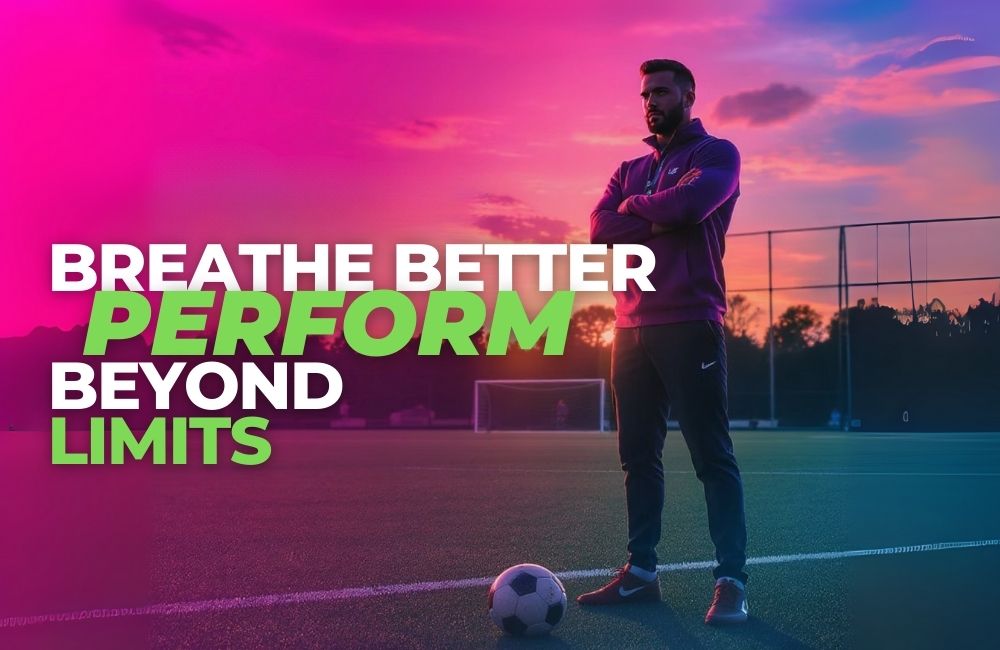 Discover how breathwork helps soccer players supercharge focus, stay calm under pressure, prevent early muscle fatigue, and build the mental toughness scouts look for.
Discover how breathwork helps soccer players supercharge focus, stay calm under pressure, prevent early muscle fatigue, and build the mental toughness scouts look for.
So you want to play with more consistency, feel mentally stronger, stay emotionally balanced, and even feel physically sharper on the pitch? Cool.
If you want to take the next step in your game - maybe even get closer to your dream of becoming a pro player - let me tell you a little secret:
👉 Once coaches tell you that you’ve got the potential, it’s no longer about raw talent.
From that point on, it’s your mind that makes the difference.
Because what separates good players from excellent players is simple:
And here’s the thing: this is exactly what scouts, clubs, and academies are looking for. 75% of a scouting report is based on how you do when you are not in possession of the ball. Your focus and attention, your resilience, how you bounce back after mistakes, your communication, body language etc - all of this matters more than most would think.
How do I know? Because I work with the best - from NWSL players to the German Bundesliga and even the English Premier League. Teams include Gotham FC, Bayern Munich, and Bournemouth FC. And when I talk to academy coaches at Orlando City, New York Red Bulls, or Borussia Dortmund, they all say the same thing:
👉 “It’s focus, emotional balance, and consistency that make or break - especially young player.”
So where do we start training the mind?
I say we start with your breathing.
Because your breath is the fastest, most effective way to bridge the body and the mind by influencing your nervous system. Your nervous system is the control panel of your thoughts and emotions and therefor a key driver of consistent performance.
More infos about my soccer breathwork program you can find here
The Problem: Most Athletes Breathe Wrong - and Pay the Price
When we talk about sports performance, most players think about strength, conditioning, technical drills, or even diet. What almost no one pays attention to yet, although breathwork is currently experiencing a huge boom all over the world, is performance breathing for athletes. The goal of this article is to show you the 3 most important pillars of breathwork and how strengthening your breathing, just like training any other muscle, can transform your performance. Whether you’re an athlete chasing consistency, a soccer player aiming for the next level, a parent supporting your child’s journey, or even a busy CEO under constant pressure, the right breath training builds resilience, focus, and energy you can rely on.
The truth? 87.5% of athletes breathe dysfunctionally.
That means almost 9 out of 10 players are unconsciously limiting their mental toughness, physical endurance, and emotional resilience - without even realizing it. In training sessions this shows up in most players switching to mouth breathing right from the start. This wrong habit makes you blow off too much C02 too quickly and results in your muscles and brain not being able to absorb enough oxygen due to an effect called “Bohr Effect”.
The Hidden Costs of Wrong Breathing
If you’re a soccer player, here’s how poor breathing habits are holding you back right now:
In short: poor breathing = lost potential.
Why Soccer Players Suffer Most
Soccer is one of the toughest sports for the lungs and brain because it combines:
Without trained breathing, players lose concentration, composure, and consistency - exactly the qualities scouts and coaches value most.
Your talent might get you noticed.
But your resilience, and mental toughness will determine if you stay at the top.
👉 That’s why breath training for athletes isn’t optional anymore. It’s the difference between being a good player and being the one who controls the game - mentally, physically, and emotionally.
Over the past 1.5 years, I have dedicated myself fully to becoming a certified breathwork coach, combining knowledge from three powerful traditions: the ancient science of pranayama through yoga teacher training, modern performance breath training with the Oxygen Advantage, and the emotional and therapeutic side of transformational breathing practices such as holotropic breathwork, rebirthing, and conscious connected breathing. What I realized during this journey is that most approaches to breathwork focus only on one side: either the emotional release and trauma healing techniques that target the nervous system and stress relief, or the performance-driven methods used by swimmers, surfers, and elite athletes to increase lung capacity and CO₂ tolerance. Rarely do we see an integrated approach that connects both worlds. My mission as a coach is to bridge that gap, helping athletes, high performers, and everyday people use breathwork not only for resilience, stress reduction, and emotional balance, but also for sports performance, mental toughness, and confidence under pressure.
Goal: Build a stronger core, protect your spine, and create the foundation for every movement on the pitch.
When most players think about their “core,” they picture sit-ups, planks, and ab circuits. But your true core is much more than a six-pack, it’s a pressure system. Think of it as a canister or a box.
Every time you inhale, your diaphragm contracts downward, creating intra-abdominal pressure that stabilizes the spine. Research in the Journal of Orthopaedic & Sports Physical Therapy has shown that the diaphragm actually activates milliseconds before any limb movement, meaning it anticipates and prepares the body for action before you even sprint, pass, or change direction.
If the diaphragm is weak - which it is if you don’t train or use it properly because of mouth breathing or upper chest breathing, the “canister” collapses. That leads to energy leaks aka gassing out, poor coordination between upper and lower body aka poor control on the ball, and inefficient movement patterns aka missed chances.
Why core strength matters for soccer performance
Why it matters for ACL injury risk - especially in female players
ACL injuries are a global crisis in soccer, especially in women’s football. According to recent FIFA research, female players are 2–6 times more likely to tear their ACL compared to men, with 80% of those injuries occurring in non-contact situations like landing or cutting. (FIFA Women’s Football Research Programme, 2022).
One critical risk factor? Trunk stability. If the core wobbles during high-force movements, the knees take the load. By strengthening the diaphragm and pelvic floor, players improve neuromuscular control of the trunk, which directly influences landing mechanics and cutting angles. Systematic reviews, such as Gokeler et al. (2013), show that poor trunk control is strongly associated with ACL injury risk. Zazulak et al., 2007 (Am J Sports Med):
And here’s the good news: FIFA’s own “11+ prevention program” has reduced ACL injuries by up to 45% in female footballers (Soligard et al., British Journal of Sports Medicine, 2008). Breathing training fits directly into this prevention model by reinforcing core stability from the inside out.
Looking at all these facts we can say for athletes and especially for female players, integrating breathwork into performance training is more than just an edge, it’s a form of injury insurance.
Even the world’s best athletes know this. Take Steph Curry, for example, who is known for his accuracy in shooting but also for his consistency under pressure and his relentless work ethic.
Few people know this, but Curry incorporates breath training into every single practice session. He often finishes workouts by training his diaphragm strength using sandbags on his stomach, forcing his breath to work against resistance.
Why? Because he knows that when his breathing muscles are stronger, he doesn’t gas out late in games. His focus, communication, and confidence stay sharp when everyone else is tired. That’s part of what makes him one of the most resilient players in basketball history.
If one of the greatest shooters of all time invests in breathwork for mental toughness and sports performance, why shouldn’t soccer players do the same?
Soccer is no different. A strong diaphragm gives you a stable trunk, which means sharper sprints, cleaner touches, fewer compensations and ultimately, fewer injuries.
Breathwork isn’t just about calming nerves or getting more oxygen. It’s biomechanics as step one. Training your diaphragm improves movement efficiency, core stability, and injury resilience, especially in high-risk areas like the ACL. Without this foundation, everything else like your speed, your focus, your communication, it all sits on shaky ground.
Goal: Deliver more oxygen, boost repeat sprint ability, and build unshakable mental resilience
For a long time I also believed and even learned in my sports science classes that fatigue comes from a lack of oxygen and too much lactic acid build up. But new scientific research has emerged since then. Let me explain what science knows as of today and what it has to do with breathing.
Here’s the science: as you play and as your muscles contract, our mitochondria not only produce energy but also CO₂ naturally rises in your blood. (mitochondria are like the power plants of our body) But instead of being a “waste gas,” CO₂ is actually the trigger that allows oxygen to be released from the blood into your muscles and brain. This mechanism is known as the Bohr Effect (Bohr, 1904). If your body panics and forces you to breathe too much and too fast through the mouth and upper chest, you throw the body out of its optimal CO2 balance. The result? Oxygen stays “locked” in the blood instead of fueling your legs and brain.
The real challenge isn’t lactate itself — it’s the buildup of hydrogen ions (H⁺), which makes your blood and muscles more acidic, interfering with contraction and accelerating fatigue.
Most players think “more breathing = more oxygen = better performance.” But the real key is carbon dioxide (CO₂).
Here’s why:
When CO₂ builds up, it triggers the Bohr Effect → it tells hemoglobin to release oxygen where it’s needed.
👉 So if you can tolerate higher CO₂ levels, your body delivers more oxygen to your muscles and brain at the exact moment you need it.
In short:
Less CO₂ tolerance = oxygen stuck on the bus.
Better CO₂ tolerance = oxygen delivered to your legs, brain, and heart faster.
By improving your breathing you are training your tolerance to higher CO₂, you improve oxygen uptake to the brain and muscles by up to 20% - meaning clearer thinking, faster reactions, and more explosive sprints, especially late in the game when others are fading.
Why oxygen delivery matters for soccer performance
Why breath holds matters for mental toughness and performance anxiety
Performance anxiety is one of the biggest hidden barriers for athletes. Studies show that athletes with dysfunctional breathing patterns are far more likely to experience pre-game nervousness, intrusive thoughts, and slower reaction times (Jones & Smith, Journal of Sports Sciences, 2018).
Modern research, including Tim Noakes’ Central Governor Theory, shows the brain acts as a ‘safety regulator.’ Once it senses falling oxygen delivery and rising acidity due to hyperventilation and overbreathing through the mouth, it pulls the plug: slowing you down, reducing coordination, and clouding decision-making. It’s this moment when you feel exhausted at the end of the game and your legs are shaking making it almost impossible to stop and easy pass let alone shoot with power and precision from distance or convert a penalty.
By improving CO₂ tolerance, you rewire your body’s response to stress. Instead of triggering panic when CO₂ rises, your nervous system learns to stay balanced. That’s why players who integrate breath training report not just better stamina, but also more confidence, clearer communication on the pitch, and fewer “easy mistakes” under pressure.
Breath training doesn’t just give you more power during play — it also speeds up recovery. Studies show that controlled nasal breathing activates the parasympathetic nervous system, lowering heart rate faster and improving heart rate variability (HRV) after intense exercise (Dempsey, 2020; Stanford et al., 2021). That means you reset quicker between sprints, recover faster after matches, and step into training with more energy instead of lingering fatigue.
How Novak Djokovic learned to stay calm under pressure
One of the greatest examples of biochemistry in action is Novak Djokovic, who has publicly shared how his daily breathwork, including extended breath-holds, helps him reset his mind and body during long, grueling tennis matches. By controlling his CO₂ tolerance, Djokovic keeps his brain oxygenated, sharp, and calm, even after five hours of play in extreme heat.
Novak Djokovic often talks about “conscious breathing” as a core tool in his mental toolkit. He uses it to reset during tense match moments, recover in between points, and stay present under pressure. For example:
What he emphasizes is that breathing isn’t an optional performance hack - it is central to his mental strength. He says he tries to be aware of his breathing constantly, because distractions and external pressure are inevitable, and breathing gives him something controllable, something inside of “me” to rely on.
For soccer players, the lesson is simple: if you can control your breath, you can control your performance.
Goal: Recover faster, handle pressure better & stay emotionally balanced
If Pillar 1 builds your physical foundation (breathing muscles) and Pillar 2 sharpens your body’s biochemistry (CO₂ tolerance), then Pillar 3 is about controlling the command center of your performance: your nervous system.
During a soccer game, your nervous system constantly flips between sympathetic mode (fight-or-flight) and parasympathetic mode (rest-and-recover). Both are necessary. The problem? Most players get stuck in the red zone before, during and after games.
This constant overstimulation doesn’t just hurt focus and decision-making, it slows recovery, disturbs sleep, and fuels performance anxiety. Over time, it creates inconsistency that kills careers.
Breathing is the remote control of your nervous system
Your breath is the fastest, safest and legal way to regulate your autonomic nervous system. Research from Harvard Medical School (2017)shows that slow, controlled exhalations increase vagal tone, the activity of your vagus nerve, which is directly linked to emotional regulation, calmness, and resilience.
When you train your breathing to consciously shift gears, you can:
This is why elite athletes across all sports are integrating breathwork not just for performance, but for mental training, emotional balance, and resilience under pressure.
LeBron James & emotional regulation
Take LeBron James as an example. He has spoken about using mindfulness and controlled breathing techniques to manage stress, recover quicker, and maintain focus during high-pressure moments. His ability to stay calm and composed in the NBA Finals is of course physical talent and a “nevery giving up mentality”, but also nervous system mastery.
For soccer players, the parallel is obvious: the player who stays calm after missing a penalty, who communicates clearly instead of yelling at teammates, and who recovers quickly between games, that’s the player coaches and scouts trust.
Why nervous system control is the missing key in soccer
Bottom line: Without nervous system control, all the fitness and skill in the world won’t make you reliable. Breathwork gives you the reset button that modern soccer demands: calmness before the game, composure during mistakes, and true recovery after the final whistle.
Everyone talks about mindset, but most players start in the wrong place, focusing on thoughts, doing visualizations or emotions trying to meditate because experts keep on telling them this is the way to go. But when your nervous system is stuck in fight or flight mode it’s almost impossible to start like this - and most certainly you won’t see any positive effects and just get more frustrated or even more overthinking.
The reality is that those who need mindfulness the most often cannot access it. Their nervous system is in constant overdrive. Their CO₂ tolerance is low, so they panic easily. Their breathing mechanics are off. Without these basics, mental training offers little benefit.
Mental Techniques like visualization, meaningful goal setting, overcoming performance blockers, transforming limiting subconscious beliefs, mastering self-talk under pressure, and communicating effectively with teammates, coaches, and staff all require a calm, regulated system to start with.
Success also depends on emotional intelligence: understanding your vision and purpose, recognizing different personality types, and managing interpersonal team chemistry. Without a stable nervous system and proper breath control, even the best mental strategies cannot fully improve performance or unlock potential.
True mental strength starts with your breathing.
Because your breath is what helps you anchor yourself in the present moment, control your thoughts, influence your emotions, and your ability to perform and have meaningful relationships.
When you control your breath:
That’s what separates average players from those who make the difference.
Ready to Become the Player No Coach Would Sub Off?
Train your breath and you’ll train your body, your mind, and your emotions.
All at once. To learn more about my soccer breathwork program - click here!
This is the missing piece. And once you learn it, you’ll never look at your game the same way again.
Breathwork is your gamechanger.
yours, Stefan Peter - certified Oxygen Advantage Breathwork Teacher and Mental Performance Coach
About the author

Stefan Peter, MAS in Sports Health and Leadership
With more than a decade of coaching experience and my own background as a young athlete it is my goal to help you perform better, but most importantly help your personal growth on and off the pitch.
" So many young athletes only perform in training, but block their own performance when it gets tough. Training the mental side of the game is essential these days and the earlier you start the better it is. Together we can work on things like correct goal setting, the steps to visualization that actually work, improving communication and overcoming limiting thoughts, emotions and beliefs.


BRAINZ MAGAZINE
Also read my mindset and personal development articles at Brainz Magazine - reaching over 2 million peope every year!

1:1 Mindset Strategy Call
book your first 20mins strategy call where we talk about your goals and current challenges and create a custom plan for your performance
